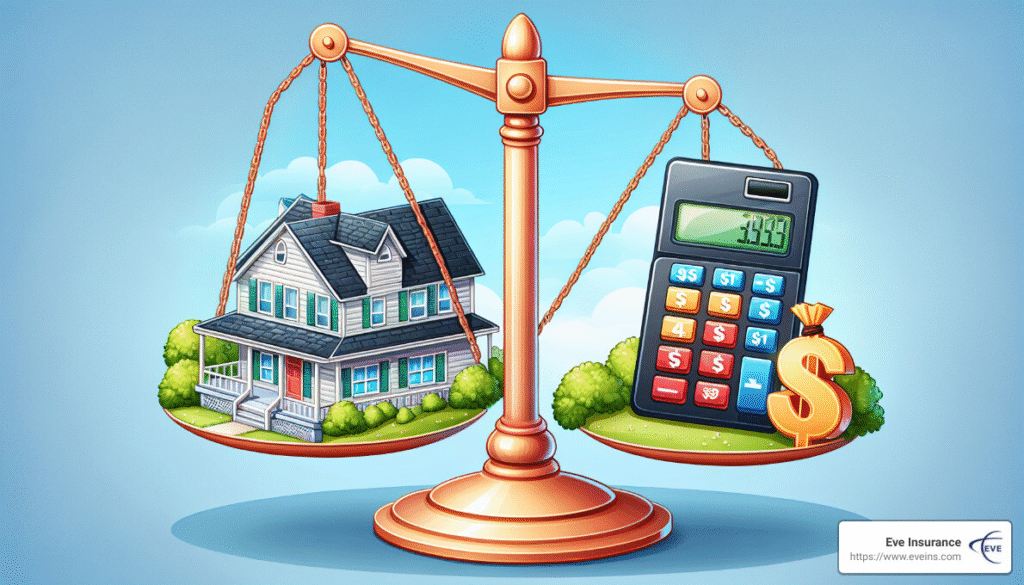Introduction
Homeownership is a major milestone in life, and protecting that investment is a top priority. That’s why most homeowners purchase home insurance, believing it will safeguard them from natural disasters, theft, accidents, or other unforeseen events. But here’s the critical question: Is your home insurance policy truly protecting you as you expect? The unfortunate truth is that many homeowners only discover the limitations of their coverage when it’s too late.
This in-depth article will help you evaluate your current home insurance policy, identify coverage gaps, and understand what you can do to ensure your home is genuinely protected.
Key Takeaways
- Standard home insurance doesn’t cover everything. Know the exclusions.
- Review and update your policy annually to reflect life and property changes.
- Consider additional coverage for floods, earthquakes, or high-value items.
- Ensure your dwelling coverage is based on replacement cost, not market value.
- Boost liability protection and consider umbrella insurance for lawsuits.
- Maintain a home inventory to support claims.
- Work closely with your insurance provider to tailor coverage to your needs.
What Is Home Insurance?
Home insurance, also known as homeowners insurance, is a type of property insurance that provides financial protection against damage to your home and belongings. It typically includes liability coverage if someone is injured on your property and may also cover living expenses if you are temporarily displaced.
Policies are usually structured into four key areas:
- Dwelling Coverage: Protection for the structure of your home.
- Personal Property Coverage: Covers your belongings inside the home.
- Liability Protection: Helps pay for legal costs if you’re sued for injuries or damage.
- Additional Living Expenses (ALE): Covers temporary housing and meals if your home is uninhabitable.
However, each of these areas can have significant limitations depending on your policy’s specifics.
Signs Your Home Insurance May Not Be Protecting You
- Underinsured Dwelling Amount Many homeowners base coverage on the home’s market value rather than its replacement cost, which can lead to major shortfalls in a claim.
- Lack of Flood or Earthquake Coverage Standard policies do not cover natural disasters like floods or earthquakes. These require additional riders or separate policies.
- High Deductibles A high deductible lowers your premium but can make it financially difficult to file smaller claims.
- Outdated Personal Property Limits Valuables like jewelry, electronics, and collectibles often have coverage caps. You may need endorsements for full protection.
- Excluded Perils Damage from mold, pests, and gradual wear and tear is usually not covered.
- Low Liability Limits If someone sues you after an injury on your property, inadequate liability limits can lead to out-of-pocket costs.
- Lack of Regular Reviews and Updates Life changes like renovations, new purchases, or rising construction costs can make your existing policy outdated.
How to Know If Your Home Insurance Is Enough
- Review Your Declarations Page: This summary outlines your coverages, limits, and deductibles.
- Assess Replacement Cost: Ensure your policy covers the cost to rebuild, not the market value.
- Inventory Your Belongings: A home inventory helps determine if personal property limits are sufficient.
- Ask About Add-Ons: Inquire about endorsements for high-value items, identity theft protection, and water backup.
- Check Your ALE Coverage: Ensure you have adequate coverage for temporary living expenses.
Steps to Strengthen Your Home Insurance Policy
- Increase Dwelling Coverage Adjust your policy to cover full rebuild costs, considering inflation and material/labor costs.
- Add Riders or Endorsements Examples include:
- Scheduled Personal Property
- Flood Insurance (via NFIP or private insurer)
- Earthquake Coverage
- Sewer/Water Backup
- Raise Liability Limits or Add Umbrella Insurance Increase protection beyond standard limits to avoid lawsuits affecting your finances.
- Upgrade Personal Property Coverage Opt for “replacement cost” rather than “actual cash value” to receive full reimbursement.
- Bundle Policies Combine home and auto insurance to receive discounts and streamline your coverage.
- Schedule Annual Reviews Regularly meet with your insurance agent to update your policy based on life or property changes.
What Should You Look for in the Best Home Insurance Policy?
Description: A detailed guide that walks readers through how to evaluate and compare home insurance policies—from premiums and deductibles to exclusions, endorsements, customer service, and claim response time.
How Can You Lower Your Home Insurance Premium Without Losing Coverage?

Description: Focuses on cost-saving strategies including bundling, increasing deductibles, installing security systems, maintaining good credit, and reviewing policy features to avoid overpaying.
What Are the Most Common Home Insurance Claim Mistakes to Avoid?
Description: Covers errors like delayed filing, insufficient documentation, misunderstood coverage, and incorrect repair estimates. Offers actionable tips for a smoother claim process.
Is Flood Insurance Necessary If You Already Have Home Insurance?
Description: Explores the limits of standard home insurance regarding flood damage and explains why flood insurance may be essential even if you’re not in a high-risk zone.
How Does Home Insurance Cover Natural Disasters and Climate Events?
Description: Analyzes how well standard policies protect against hurricanes, wildfires, earthquakes, and other climate risks—and what add-ons or riders are necessary.
Can Renovations and Upgrades Affect Your Home Insurance?
Description: Discusses how remodeling your kitchen, adding a room, or improving security systems can impact premiums, dwelling coverage needs, and risk assessments.
What Is the Difference Between Actual Cash Value and Replacement Cost in Home Insurance?
Description: Explains these two valuation methods in-depth, with case examples to show how they affect payouts and why replacement cost coverage may offer better protection.
Should You Bundle Home and Auto Insurance? Pros and Cons Explained
Description: Investigates the benefits of bundling, including discounts and simplified management, while also considering potential downsides like less flexibility or customer service issues.
How to File a Home Insurance Claim Step by Step
Description: Offers a comprehensive, practical guide for policyholders on navigating the claim process—from assessing damage and contacting the insurer to repairs and settlement.
What Is Umbrella Insurance and Do You Need It with Your Home Policy?
Description: Describes how umbrella insurance provides additional liability protection beyond the limits of your home insurance and when it’s a wise investment.
How Does Your Home Insurance Respond to Climate Change Risks?
Long Description:
As climate change intensifies natural disasters—like wildfires, floods, hurricanes, and extreme heat—homeowners need to reassess how well their insurance covers these evolving threats. This article can explore how insurers are adapting to rising risk levels, the difference between standard policies and add-on disaster coverage, and how to evaluate whether your property is vulnerable to new environmental threats. It should also offer strategies for risk mitigation and securing proper endorsements.
What’s the Real Cost of Being Underinsured as a Homeowner?
Long Description:
Many people don’t realize the financial consequences of underinsurance until it’s too late. This article will delve into what “underinsured” really means, using real-world claim examples. It will explain how replacement cost vs. actual cash value works, how inflation and home upgrades affect insurance adequacy, and how to perform a full coverage check. It should conclude with steps to avoid underinsurance, such as policy reviews and endorsements.
Is Your Personal Property Fully Covered by Home Insurance?
Long Description:
Personal property is one of the most misunderstood areas in home insurance. This guide will explain what standard policies cover, how limits apply to categories like electronics, jewelry, and collectibles, and why documentation like home inventories matters. It will also cover replacement cost vs. depreciation, coverage for items stored off-premises, and when scheduled personal property riders are essential.
What Happens to Your Home Insurance If You Rent Out a Room or Property?
Long Description:
With the rise of Airbnb and long-term rentals, homeowners are unknowingly exposing themselves to coverage gaps. This article explains the impact of rental activity on standard policies, the need for landlord or short-term rental endorsements, and how liability risks increase. It should also touch on business activity exclusions and how to properly insure both primary residences and rental units.
How Does Home Insurance Handle Water Damage—and What’s Not Covered?
Long Description:
Water damage is one of the most common claims—but it’s also one of the trickiest. This topic will break down what types of water damage are usually covered (burst pipes, accidental leaks) and which are not (floods, seepage, lack of maintenance). It should also explain optional coverages like water backup and sump pump failure, and how to prevent common water-related disasters.
Why Are Home Insurance Premiums Increasing—and How Can You Control Them?
Long Description:
This article will analyze the current factors driving home insurance premium hikes: inflation, rising construction costs, increased climate risks, and insurer losses. It will offer readers actionable ways to reduce their rates, such as increasing deductibles, improving home safety, bundling policies, and shopping around. It can also explore the role of credit scores, claim history, and geographic location.
How Do Deductibles Affect Your Home Insurance Claims and Premiums?

Long Description:
Many homeowners misunderstand how deductibles work. This article will explain different deductible types (flat, percentage-based), how they influence premiums, and what happens during a claim. It should also cover how to choose the right deductible based on your financial situation and property value, with comparisons and case scenarios.
What Is the Role of a Home Insurance Endorsement—and Which Ones Do You Need?
Long Description:
Endorsements (also known as riders) allow policyholders to customize their coverage. This comprehensive guide will explore popular endorsements, including sewer backup, identity theft, business property, and high-value item protection. It will help readers identify gaps in their current policies and explain how endorsements improve claim outcomes.
What Are the Hidden Exclusions in Your Home Insurance Policy?
Long Description:
Many homeowners wrongly assume their policy covers everything. This deep dive explores lesser-known exclusions like sewer backup, foundation cracks, mold, termite infestations, ordinance or law upgrades, and neglect-related damage. It educates readers on how to interpret fine print, what riders or separate policies to consider, and how insurers define “covered perils.”
How Do You Choose the Right Home Insurance Company for Long-Term Peace of Mind?
Long Description:
Beyond premiums, this article guides readers through evaluating insurers based on claim satisfaction ratings, financial strength, policy flexibility, digital tools, and customer service. It includes comparison charts, red flags to avoid (delays, claim denials), and steps to switch providers safely without a coverage gap.
How Can Smart Home Technology Help Lower Your Home Insurance Costs?
Long Description:
This piece examines how security systems, smart smoke detectors, leak sensors, and automated locks not only protect your home but also help reduce premiums. It will include insurer-backed discounts for smart home integration, a cost-benefit analysis, and a list of recommended devices insurers reward.
How Does Home Insurance Work for Condos, Townhomes, and Multi-Unit Properties?
Long Description:
A niche but growing concern, this topic explains the difference between master insurance policies and individual HO-6 policies. It also explores the risks condo owners face, what interior elements are covered, liability nuances in shared spaces, and how to handle gaps between association and personal coverage.
What Should You Do If Your Home Insurance Claim Is Denied?
Long Description:
A step-by-step guide on how to handle denied claims. Covers common reasons for denial (late reporting, exclusions, insufficient documentation), how to dispute a decision, the role of public adjusters, and legal rights under insurance law. Includes real-life scenarios and how to escalate to your state’s insurance commissioner.
Is Replacement Cost or Actual Cash Value Better for Your Home Insurance?
Long Description:
This article explores the critical financial difference between the two valuation methods. With side-by-side examples, it highlights the benefits and limitations of each when it comes to rebuilding your home or replacing your possessions after a loss, helping readers make an informed policy choice.
How Do Building Codes Affect Your Home Insurance Claims and Payouts?
Long Description:
Outdated wiring, plumbing, or HVAC systems may not meet modern codes—and rebuilding after damage might require upgrades. This article explores ordinance or law coverage, what it is, why it’s often missing from standard policies, and how much protection you may need to avoid massive out-of-pocket costs.
What Homeowners Need to Know About Seasonal or Secondary Home Insurance
Long Description:
If you own a vacation home or rent out a second property part-time, standard home insurance may fall short. This guide outlines how secondary home risks differ, what specialty policies or endorsements are required, how short-term rentals change coverage, and how to avoid high premiums.
How to Build a Home Inventory That Speeds Up Your Insurance Claim
Long Description:
Many homeowners overlook the importance of a comprehensive home inventory—until disaster strikes. This article explains why documenting your possessions is crucial for claims, how to build a digital or physical inventory, the best tools and apps available, what details insurers expect (photos, receipts, serial numbers), and how to keep your list updated. It can include downloadable templates and checklists for reader value.
How to Navigate the Home Insurance Claim Process After a Disaster

Long Description:
Filing a claim after your home is damaged can be overwhelming. This article offers a step-by-step walkthrough of the process—from initial damage assessment and calling your insurer to working with adjusters, receiving estimates, handling disputes, and avoiding common pitfalls that delay payouts. Includes guidance on temporary repairs, documentation, and understanding settlement offers.
Why You Should Review Your Home Insurance Policy Every Yea
Long Description:
Life changes fast—renovations, new furniture, inflation, family additions, and more. This article discusses why yearly policy reviews are essential, how to conduct one effectively, and what questions to ask your insurance agent. It can include a review checklist and insights into how small changes in your policy can save money or improve protection.
What You Need to Know About Insurance for Older or Historic Homes
Long Description:
Older homes and historic properties present unique insurance challenges: outdated electrical systems, plaster walls, antique materials, or non-code features. This article dives into why such homes require specialized policies, the cost of restoring original materials, potential insurer limitations, and how to find the right coverage without overpaying.
Should You Choose a Local or National Insurance Provider for Your Home?
Long Description:
This comparison guide evaluates the pros and cons of going with a local insurer (more personalized service, regional expertise) versus a national one (broader resources, digital tools). It also considers pricing differences, claim speed, customer support, and how reputation matters when selecting a carrier.
What Every First-Time Homebuyer Needs to Know About Home Insurance
Long Description:
Perfect for educating new homeowners, this guide walks readers through the essentials: how to choose the right coverage, why lenders require insurance, what’s commonly excluded, and how to avoid common mistakes like choosing the lowest premium over proper coverage. A “home insurance checklist” for new buyers could add value.
Is Your Detached Garage or Shed Covered by Your Home Insurance?
Long Description:
This niche but useful article explores how “other structures” coverage works within a standard policy. It discusses how much coverage is typically offered, what’s included (garages, fences, gazebos, workshops), and when you may need to increase limits or add endorsements—especially if those structures contain tools, equipment, or serve business purposes.
How Can You Protect Your Home Insurance Rate from Going Up
Long Description:
After a claim or even a near-miss event, insurance rates often rise. This article offers strategies for minimizing premium hikes—such as avoiding frequent small claims, improving home safety, staying loyal to insurers with claim forgiveness, and knowing when to switch providers. It also includes insight into CLUE reports and how insurers track claim history.
How Do Renovations Affect Your Home Insurance—and When Should You Tell Your Insurer?
Long Description:
This guide explains how home improvements (kitchen remodels, new roofs, additions, pools) impact replacement cost, risk profile, and liability exposure. It outlines which renovations require you to notify your insurer and how failure to do so can void claims. Readers will also learn how to adjust their policies mid-renovation for ongoing protection.
What Is Loss of Use Coverage—and Why Is It a Lifesaver During a Crisis?
Long Description:
Loss of Use or Additional Living Expenses (ALE) is often overlooked until disaster hits. This article dives deep into what ALE covers (temporary housing, meals, transport), how much is usually provided, how to claim it, and common limits or exclusions. It will help readers make sure this part of their policy is adequate.
What Happens If You Don’t Have Enough Home Insurance During a Major Loss?
Long Description:
Many homeowners discover they’re underinsured only after facing a catastrophic event—like a fire, hurricane, or major storm. This article explores the real-life consequences of insufficient coverage, including:
- What happens if your dwelling coverage falls short of rebuild costs.
- How actual cash value vs. replacement cost affects claim payouts.
- The dangers of undervaluing personal property or liability needs.
- Why extended or guaranteed replacement cost coverage can be a financial lifesaver.
It will walk readers through common underinsurance traps (e.g., inflation, renovations, failing to update coverage) and provide a step-by-step guide to reassessing and correcting gaps before disaster strikes.
How Can You Customize Your Home Insurance to Match Your Unique Lifestyle?
Long Description:
No two homes—or homeowners—are exactly alike. This article shows how readers can personalize their home insurance to reflect their lifestyle, assets, and risk tolerance. It explores:
- Endorsements for valuables (jewelry, art, collectibles).
- Coverage for home-based businesses or freelancers working from Home.
- Vacation home and Airbnb considerations.
- Higher liability limits for homes with pools, trampolines, or dogs.
- Identity theft protection, green home upgrades, and inflation guards.
This guide empowers readers to think beyond the one-size-fits-all model and helps them build a tailored policy that evolves as their life changes.
Also read : Are You Paying Too Much for Your Health Insurance Plan?
Conclusion
Your home is one of your most significant investments, and the right insurance policy is essential for safeguarding it. Many homeowners mistakenly believe their standard policies offer blanket protection, only to discover limitations at the worst possible time. By understanding your current coverage, identifying gaps, and proactively enhancing your policy, you can ensure peace of mind and financial stability.
Don’t wait until disaster strikes to find out if you’re underinsured. Take action today to review, adjust, and strengthen your home insurance policy so that it truly protects what matters most.
FAQs
What is not covered by a standard home insurance policy? Standard policies typically exclude flood, earthquake, pest infestation, mold, and wear-and-tear damage.
Does home insurance cover roof leaks or damage? Only if the damage is sudden and accidental, such as from a storm. It won’t cover wear and tear or lack of maintenance.
Can I insure my home for more than its market value? Yes. You should insure it for its replacement cost, which may be higher than the market value, especially in high-construction-cost areas.
How often should I update my home insurance policy? At least once a year, or after major life or home changes such as renovations or large purchases.
What happens if my claim exceeds my policy limits? You will be responsible for paying the difference out of pocket unless you have additional coverage such as an umbrella policy.
Do I need home insurance if I own my home outright? Legally, no. But it is highly recommended to protect your investment from unexpected events.
Is home insurance tax deductible? Generally, no. However, if you use part of your home for business, that portion of your policy may be deductible.



